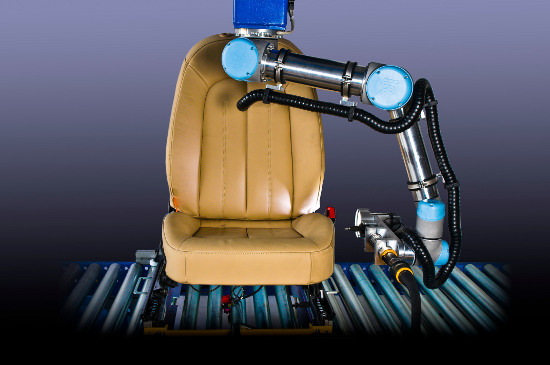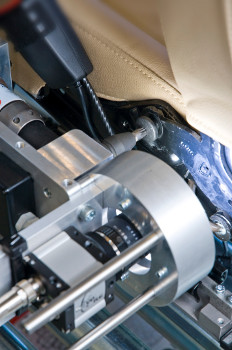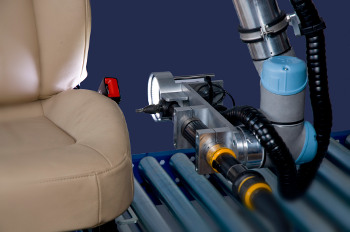 |
| April 02, 2013 | Volume 09 Issue 13 |
Designfax weekly eMagazine
Archives
Partners
Manufacturing Center
Product Spotlight
Modern Applications News
Metalworking Ideas For
Today's Job Shops
Tooling and Production
Strategies for large
metalworking plants
Measuring robots ensure 'just-in-time' assembly of car seats
In automotive supplier Lear Corporation's demand-led production, robot arms from Universal Robots play a crucial role: The lightweight robots assemble car seats by locating, measuring, and tightening screws on car seats, resulting in shorter throughput time and greater process reliability.

The UR5 robot from Universal Robots is installed above the conveyor belt that transports car seats in Lear's Besigheim, Germany, plant. The seats have already been pre-screwed by hand. Unlike other industrial robots, the easy-to-program UR robots need no safety shielding, so personnel can work alongside the robots.
Just-in-time assembly (JIT) is an established production model in the supplier industry enabling considerable cost savings on the part of the customer. For the supplier, however, this means superlative flexibility, because the company must be in a state of constant preparedness for deliveries while also meeting strict quality requirements. When it comes to safeguarding all of this and avoiding errors, reliable production processes are imperative.
The Lear Corporation is an international automotive supplier specializing in seat systems and on-board electronics. At its production facility in Besigheim, Germany, car seats are assembled "just in time" by workers operating in a shift pattern. The key is to work quickly and flexibly while guaranteeing high-quality products. The employees had only limited experience with robot technology, which is why the desired automation technology had to be low maintenance, easy to control, and simple to program.
One particular challenge on this project came from the limited space available inside the production hall, where the individual production steps take place one after the other on a conveyor belt. Lear needed a small, mobile robot that could be used directly alongside humans.
Side by side with a robot colleague
The systems integrator Faude Automatisierungstechnik was able to provide a solution satisfying all of the requirements: the six-axis, lightweight UR5 robot from Danish manufacturer Universal Robots. The small robot weighs just 18 kg (40 lb)and has a reach of 85 cm (33 in.) and a lifting force of 5 kg (11 lb).
A key advantage to Lear is the robot's intuitive user interface. Programming is done by either pressing arrow keys on a touchpad, indicating where the robot should move, or by simply grabbing the robot arm and showing it how to perform a certain action. Lear needed just a single day of training to familiarize employees with the robots. Unlike room-size, heavy-automation technology, this robot can be used directly alongside humans without any safety shielding: As soon as an employee comes in contact with the robot arm and a force of at least 150 N or more is exerted, the robot arm will automatically stop operating. This safety mode has been certified in accordance with the European ISO standard. Faude also checked the robots' individual applications on all projects in order to rule out any safety risks.
Contribution to quality assurance
Since January 2011, the UR5 robots have been responsible for screwing together the seat and rest frames, the last and most important stage of production before final assembly at Lear's plant in Besigheim. Each robot is used in three-shift operation, completing around 8,500 screwing actions every day. The UR5 is installed above the conveyor belt on which the seats, which have already been pre-screwed by hand, move. Each seat is equipped with a transponder that contains individual identification data. As soon as the seat arrives underneath a robot, the transponder is read and the robot tightens several screws on both sides of the car seat with a torque up to 35 Nm at a pre-specified rotational angle. The entire process is documented using the electric screwdriver attached to the robot.

With a torque up to 35 Nm at a pre-specified rotational angle, the UR5 robot measures and tightens up to 8,500 screws per day.
Since the seats can be in slightly different positions as a result of the previous manual stages in the process, the robot must be able to detect within a grid of 50 x 50 mm where the relevant screw is. This has been accomplished using the Flexvision image-processing system, developed by Faude, that communicates with the UR5. Using 2D measurements with a camera, the robot is positioned precisely so it can position the screw bit exactly on the head of the screw. Because of the UR5's six axes, it is so mobile that it can quickly assume the correct angle of rotation. Before being integrated into live production, Faude and Lear tested the interfaces with the robot and the influences of light in order to determine the best possible camera settings.
Since the screwing processes are monitored digitally, the robot can immediately spot errors via its image-processing system. The automation of this key stage ensures increased process reliability. If, for example, there are screws missing on a seat, the robot picks this product out and issues a warning signal by way of error notification. The Lear employee will then add missing screws manually at a reworking station. Since the robot tightens and monitors a high number of screws before final assembly, it is making a crucial contribution to quality assurance and the prevention of errors.
Cost-effective investment with potential for expansion
The procurement cost of this system solution, including the robot, was around 50,000 euros and was recouped after just a few months. Instead of expensive sensor technology, the UR5 robotic arm utilizes a patented technology to measure electrical current in its joints to determine force and movement. This innovation enables the robot to undercut the price of other automated solutions.

Each car seat is equipped with a transponder that contains individual identification data. When the seat arrives underneath the robot, the transponder is read by using the Flexvision image processing system, and the robot tightens several screws on both sides of the car seat.
Thanks to the UR5's energy-efficient operation, even the ongoing operating costs are manageable. The German auto supplier is currently examining whether the fully automatic screwing of car seats can be integrated into production across the whole of Europe. Other application uses, such as in joining, bonding, and sawing, are also being researched.
Closing the Asian "automation gap"
Because the cost of labor in traditional low-wage countries in Asia is on the rise, it's not only in Europe that employing a robot makes sense. What is paramount is the robot's ability to increase productivity and optimize production standards.
One area in which the UR robot has proven its success is in closing the "Automation Gap," which describes the challenge of transferring a semi-completed product to the next automation line or to feed work pieces for further process. In these cases, the UR robot has been easy to implement, while also freeing up workers to perform more challenging tasks. Examples of these applications within the Asian region include CNC feeding and injection-molding machine tending.
Robot programmed in 30 minutes
Due to its intuitive graphical user interface (GUI), the UR robot can be set up and programmed in as little as half an hour. The user does not need to be a skilled programmer to do this, as programming can be done by dragging and dropping standard routines into an on-screen "script" for the robot, or by simply grabbing the robot arm and showing it the desired movement.
Universal Robots developed the GUI, called Polyscope, which runs on top of a Linux OS platform for easy customization of tasks and tools. The Polyscope programming developer utility needed for this is supplied with the robot.
The robot is also equipped with digital and analog I/O ports and Ethernet interfaces for communication with external equipment and other control systems such as PLC and SCADA systems through the I/O or Ethernet socket. The robot and controller can control a small cell as well as sensors, vision systems, activation of conveyors, and other external equipment.
The robot family
UR5 has a "big brother," the UR10, that can handle a payload up to 10 kg (22 lb). The robots are a result of many years of intensive research in robotics. The UR5 was deemed the "world's most innovative robot" last year by the International Federation of Robotics, IEEE Robotics and Automation Society.
Source: Universal Robots
Published April 2013
Rate this article
View our terms of use and privacy policy
